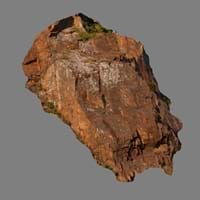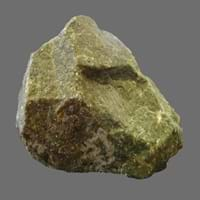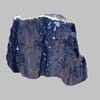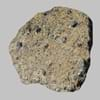Definition
Granophyre is a type of granitic rock which consists of intergrown feldspar and quartz crystals in a medium to fine grained groundmass
Dunite is a green to brownish coarse-grained igneous rock mainly consisting of olivine
Origin
Unknown
New Zealand
Discoverer
Unknown
Ferdinand von Hochstetter
Etymology
From German Granophyr, from Granit granite + Porphyr
From the name of Dun Mountain, New Zealand, + -ite1
Class
Igneous Rocks
Igneous Rocks
Sub-Class
Durable Rock, Hard Rock
Durable Rock, Medium Hardness Rock
Other Categories
Coarse Grained Rock, Fine Grained Rock, Medium Grained Rock, Opaque Rock
Coarse Grained Rock, Opaque Rock
Texture
Granophyric
Phaneritic
Color
Black, Grey, Orange, Pink, White
Dark Greenish - Grey
Durability
Durable
Durable
Scratch Resistant
Yes
Yes
Appearance
Veined or Pebbled
Rough and Shiny
Interior Uses
Bathrooms, Countertops, Decorative Aggregates, Entryways, Floor Tiles, Flooring, Homes, Hotels, Interior Decoration, Kitchens, Stair Treads
Decorative Aggregates, Interior Decoration
Exterior Uses
As Building Stone, As Facing Stone, Bridges, Garden Decoration, Office Buildings, Paving Stone
As Building Stone, As Facing Stone, Garden Decoration, Paving Stone
Other Architectural Uses
Not Yet Used
Curbing
Construction Industry
As Dimension Stone
As Dimension Stone, Cement Manufacture, Construction Aggregate, for Road Aggregate, Making natural cement, Raw material for the manufacture of mortar
Medical Industry
Not Yet Used
Not Yet Used
Antiquity Uses
Artifacts, Monuments, Sculpture, Small Figurines
Artifacts, Monuments, Sculpture, Small Figurines
Commercial Uses
Curling, Gemstone, Laboratory bench tops, Tombstones
Creating Artwork, Gemstone, Jewelry, Source of Chromite, Platinum, Nickel and Garnet, Source of Diamonds
Types
Not Available
Not Available
Features
Available in Lots of Colors and Patterns, It is One of the Oldest, Strongest and Hardest Rock
Constitutes upper part of the Earth's mantle, Generally rough to touch, Host rock for Diamond, Is one of the oldest rock
Archaeological Significance
Famous Monuments
Data Not Available
Data Not Available
Famous Sculptures
Data Not Available
Data Not Available
Pictographs
Not Used
Used
Petroglyphs
Not Used
Used
Formation
Granophyre is a fine-grained, hard rock which is a type of metasomatite, essentially altered basalt. It forms with or without crystallization, either below the surface as intrusive rocks or on the surface as extrusive rocks.
Dunite is a plutonic ultramafic igneous rock consisting almost m olivine. It can be formed in two ways.
Mineral Content
Hornblade, Orthoclase, Plagioclase, Quartz
Amphibole, Chromite, Garnet, Magnesium, Olivine, Phlogopite, Plagioclase, Pyroxene
Compound Content
Aluminium Oxide, CaO, Iron(III) Oxide, FeO, Potassium Oxide, MgO, MnO, Sodium Oxide, Phosphorus Pentoxide, Silicon Dioxide, Titanium Dioxide
Ca, CaO, Fe, Potassium, Silicon Dioxide, Sodium, Titanium Dioxide
Types of Metamorphism
Burial Metamorphism, Impact Metamorphism
Burial Metamorphism, Cataclastic Metamorphism, Contact Metamorphism
Types of Weathering
Biological Weathering
Biological Weathering, Chemical Weathering, Mechanical Weathering
Types of Erosion
Glacier Erosion, Sea Erosion, Wind Erosion
Coastal Erosion, Glacier Erosion, Water Erosion
Grain Size
Medium to Fine Coarse Grained
Coarse Grained
Fracture
Not Available
Irregular
Porosity
Less Porous
Less Porous
Luster
Dull to Grainy with Sporadic parts Pearly and Vitreous
Shiny
Cleavage
Not Available
Imperfect
Toughness
Not Available
2.1
Specific Gravity
2.6-2.7
3-3.01
Transparency
Opaque
Translucent to Opaque
Density
2.6-2.8 g/cm3
2.84-2.85 g/cm3
Resistance
Heat Resistant, Wear Resistant
Heat Resistant, Pressure Resistant, Wear Resistant
Deposits in Eastern Continents
Asia
China, India, Iran, Saudi Arabia, Sri Lanka, Taiwan, Thailand, Turkey, Vietnam
China, India, Indonesia, Kazakhstan, Russia, South Korea, Thailand, Turkey
Africa
Angola, Egypt, Madagascar, Namibia, Nigeria, South Africa
Morocco, South Africa
Europe
Austria, Belgium, Finland, France, Germany, Italy, Norway, Sardinia, Spain, Switzerland, The Czech Republic, Venezuela
Finland, France, Georgia, Germany, Great Britain, Italy, Kazakhstan, Netherlands, Norway, Spain, Switzerland, Venezuela
Others
Not Yet Found
Not Yet Found
Deposits in Western Continents
North America
Canada, USA
Canada, USA
South America
Not Yet Found
Argentina, Brazil, Colombia, Ecuador, Venezuela
Deposits in Oceania Continent
Australia
Not Yet Found
New Zealand, Western Australia
Granophyre vs Dunite Characteristics
Though some rocks look identical, they have certain characteristics which distinguish them from others. Characteristics of rocks include texture, appearance, color, fracture, streak, hardness etc. Granophyre vs Dunite characteristics assist us to distinguish and recognize rocks. Also you can check about Properties of Granophyre and Properties of Dunite. Learn more about Granophyre vs Dunite in the next section. The interior uses of Granophyre include Bathrooms, Countertops, Decorative aggregates, Entryways, Floor tiles, Flooring, Homes, Hotels, Interior decoration, Kitchens and Stair treads whereas the interior uses of Dunite include Decorative aggregates and Interior decoration. Due to some exceptional properties of Granophyre and Dunite, they have various applications in construction industry. The uses of Granophyre in construction industry include As dimension stone and that of Dunite include As dimension stone, Cement manufacture, Construction aggregate, For road aggregate, Making natural cement, Raw material for the manufacture of mortar.
More about Granophyre and Dunite
Here you can know more about Granophyre and Dunite. The life cycle of a rock consists of formation of rock, composition of rock and transformation of rock. The composition of Granophyre and Dunite consists of mineral content and compound content. The mineral content of Granophyre includes Hornblade, Orthoclase, Plagioclase, Quartz and mineral content of Dunite includes Amphibole, Chromite, Garnet, Magnesium, Olivine, Phlogopite, Plagioclase, Pyroxene. You can also check out the list of all Igneous Rocks. When we have to compare Granophyre vs Dunite, the texture, color and appearance plays an important role in determining the type of rock. Granophyre is available in black, grey, orange, pink, white colors whereas, Dunite is available in dark greenish - grey colors. Appearance of Granophyre is Veined or Pebbled and that of Dunite is Rough and Shiny. Properties of rock is another aspect for Granophyre vs Dunite. The hardness of Granophyre is 6-7 and that of Dunite is 3.5-4. The types of Granophyre are Not Available whereas types of Dunite are Not Available. Streak of rock is the color of powder produced when it is dragged across an unweathered surface. The streak of Granophyre and Dunite is white. The specific heat capacity of Granophyre is 0.79 kJ/Kg K and that of Dunite is 1.25 kJ/Kg K. Depending on the properties like hardness, toughness, specific heat capacity, porosity etc., rocks are resistant to heat, wear, impact, etc.Granophyre is heat resistant, wear resistant whereas Dunite is heat resistant, pressure resistant, wear resistant.





